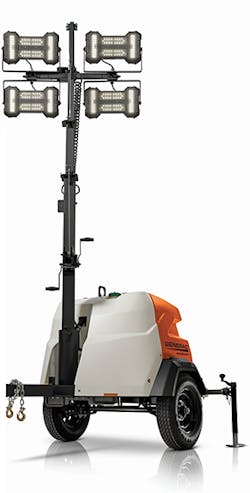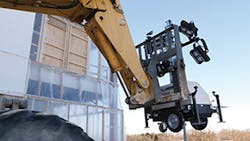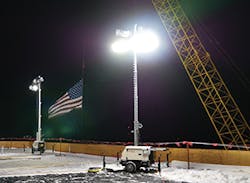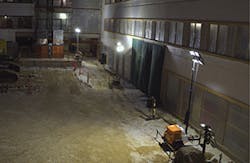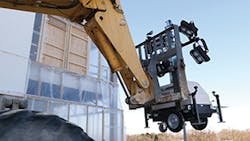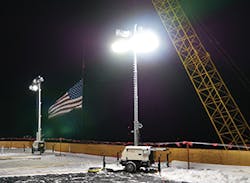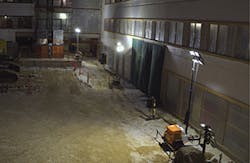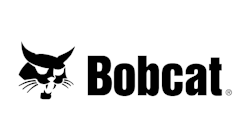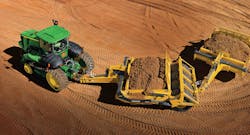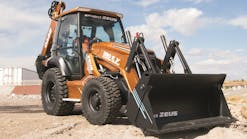Grading and excavating sites typically bring to mind big iron, but it also takes a lot of support equipment to complete a job—and even to begin one. The typical job site is home to job trailers for the foreman’s office long before utilities arrive. Trailers are filled with power-hungry systems. “You’ve got to power lights, HVAC, computers… ” says Todd Howe, manager of global generator products at Doosan Portable Power. For this around-the-clock application, he says 20 kW is common.
If a site is not serviced by the grid, you need a generator to power the job trailers, agrees Eric Massinon of Chicago Pneumatic. That generator can also power small electric tools needed onsite, such as jackhammers.
As Howe explains, the use of generators on a job site isn’t about increasing productivity. Generators are a portable utility: there is no work without them. Power is a necessity, so discussion of efficiency is secondary. “When our product doesn’t work, it’s a matter of sustaining productivity: It all stops,” he says. But, he adds, it’s not just about power availability; it’s about power quality. To stay on schedule, brown-outs must be avoided. It’s not always easy when providing power to multiple workers and tools.
Sizing Up the Job
Properly sizing a generator is the key, but that’s not always an easy task, either. “Electrical contractors can figure out the demand, but not how to order generators, so they rely on the dealer or rental company,” says Lawrence Wu, director of product management, Multiquip, Inc. He advises contractors to size the generator to the peak demand of the project over its lifetime, taking into consideration trailering equipment, lighting, computers, and tools. “It’s hard to swap out generators due to their size, so get enough for peak.”
Adding to that suggestion, Massinon recommends assessing what tools you plan to run, when you will run them, and how often you will run them. Then, he says, schedule equipment when it’s needed. “There are labor costs to pick it up, so don’t deliver generators too soon; you’re paying rent whether you’re running them or not.”
Think about the short-term application: instead of using a generator for stand-by, or emergency, power if the grid fails, a work site will need it for prime power—the primary source of electricity, usually for short durations.
The size of the project determines the size of the generator. More accurately, the size of the load determines the size of the generator. “Size the generator to the load,” explains Howe. “Load is 60% of the capacity of the generator to keep the temperature right. It’s simple math, based on what the tools require.”
Contractors should calculate how many amps for each job trailer, the watts of light needed, etc. Sizing properly can reduce costs. “Determine how many tools will you run at any given time,” continues Howe, “and run them only when needed.” However, he hastens to add, while you want to operate efficiently, you also want room for additional equipment should the need arise. “Don’t be right on the edge.”
Sizing isn’t an exact science. “You don’t have to be precise in sizing,” indicates Howe, explaining that many contractors operate generators at 70–80% of the machine’s rating. However, if a generator is too small, you must shut things down, and if it’s too big, you run the risk of wet stacking, which requires additional maintenance to correct—which is why he says that sizing properly saves money. “Too low hurts performance; too high hurts the generator in shutdown.”
“You need adequate load to operate properly,” elaborates Wu. “If you operate below 30% for a continuous time, it can wet stack.”
Wet stacking results when a diesel engine is operated on light loads for extended periods. Because it doesn’t reach proper operating temperature in this condition, it does not achieve a complete fuel burn. Unburned fuel is exhausted, creating moisture in the exhaust system. It also builds up, fouling the injectors and allowing unburned fuel and gases to escape between the piston rings and cylinder walls, leading to premature engine wear and shortening engine life. Before that occurs, excessive deposits of carbon on the exhaust valves, turbo charger, and exhaust can result in loss of engine performance.
Multiquip developed a proprietary product that mitigates the effect of a low load to prevent wet stacking. PowerBalance ensures a proper load by inducing an artificial load if the load is low and turning off if there is enough load. Because the goal was to be transparent and create a solution that would eliminate worries about how to hook it up or how it works, PowerBalance is integrated into the generators.
There are efficiency gains in diesel engines, Wu acknowledges, but on job sites, proper sizing of generators is more efficient. In fact, he says it can be more cost-effective to rent a generator, especially with a short job cycle, because tapping into utility power can be expensive.
But, Massinon cautions, schedule the time of use of the generators for when they are needed and don’t rent too many. Also, figure out whether it’s best to rent one large generator or several smaller gensets: one generator with more cable criss-crossing the job site, or multiple generators closer to the point of use.
A generator by itself is not useful, Howe notes. “You need cable, connections, electric codes, grounding . . . It’s a complex, involved process. The more you plug in, you may even need distribution panels.” But, he cautions, be sure to understand the site layout and the work being done. “Be conscious of how much electrical line you lay down . . . if it’s stretched around the site. Instead, it’s safer to move smaller generators around to reduce the amount of cord or the length of the line.”
Because smaller generators can be moved around easily, a large site is likely to have multiple compressors and generators. “Having a lot of physical cables and protection is less than ideal, so several spread out on the job site might be better,” believes Wu. Besides, he notes, cables are copper, which has significant value. Not only can they be damaged, but theft is also an issue.
Some contractors buy equipment, but because it seems that a different generator is needed for every job size, most contractors usually rent—and often pick up extra air tools while they’re at it.
It’s easier to figure out what is needed in air compressors and other tools, Wu believes. “Air compressors are rated psi and CFM. You size and number by that.” Diesel-powered air compressors can be moved around the job site, and since they may not be needed for the life of the job, can be rented for shorter periods of time. “Jackhammers are used mostly during the demolition stage, early in the project. You won’t need every tool for the life of the job.”
Even though short-term rental will help boost efficiency and lower costs, Wu says contractors care about reliability, not efficiency. It’s more important to have the tools needed than to be the most efficient possible.
As Massinon says, “Without these items, you can’t do the job.”
Pump It Up
Another item often necessary at the start of a project, and often rented, is a dewatering pump. “Many sites require dewatering pumps,” continues Massinon. The amount of water typically determines the size and number of pumps. He strongly advises putting in large enough pumps to dewater quickly. “Get in and get the work done.”
The main thing is to plan and size the work, Massinon continues. Then, get one pump reasonably sized to dewater quickly.
But Howe says reliability is as important as power when it comes to ground water pumps. “A pump is just an electric motor,” he explains. “Starting the motor is the hardest work a generator does.” Problems can arise, failures can occur. That’s why he says it’s important to use a reliable pump. “A contractor just cares about getting the job done, but he should ask about the maintenance schedule and refueling.”
Most contractors outsource fueling, Wu explains. Fueling on time and incorporating regular maintenance adds to their efficiency, especially since it’s common practice to place a pump and generator in each area where dewatering occurs, meaning that refueling can be time-consuming.
Service Trucks
A service truck brings mobile service and preventative maintenance items to the job site, saving the contractor the time and inconvenience of bringing equipment back to the shop for service. Typically, during the day, there is downtime at the work site. Even if crews work until dark, that allows the service vehicles to come to the job site while the equipment is parked and do all the preventative maintenance on them. When the team starts the next day, the equipment is ready to go to work.
Service technicians also rely on their service trucks to help them address issues that arise during the day, says Tom Wallace, sales manager at Iowa Mold Tooling Co., Inc. The service truck provides routine maintenance and assists in fixing problems onsite to get the piece of equipment back to work as quickly as possible. “Eliminating downtime is important, so the preventative maintenance that service technicians conduct ensures they catch issues before they become a problem.”
Service trucks are critical when equipment breaks down in the field, reducing downtime and getting the equipment and operator back to work as quickly as possible. Breakdowns are always expensive because if equipment is inoperable, the company has an operator who is not working and an idle piece of equipment waiting on repairs.
A new 12,000-pound crane from IMT has led to increased productivity and efficiency on the job site. The IMT 12000 telescopic crane was recently redesigned to allow teams to pull a transmission and engine out of many large scrapers and do the repairs without trying to tear the transmission and engine apart in the machine. “This innovation was market-driven,” admits Wallace, adding that it has streamlined work site activity.
Another innovation has a big impact on safety as well as efficiency. LED lights draw very little electricity, reducing the amount of electricity produced by the truck itself. Additionally, LED lights illuminate the work area for the technician very well.
LED lights are installed within the compartments of IMT service trucks, offerings technicians the ability to light up the work site. Because technicians often do repairs and servicing equipment in the dark, proper lighting is crucial to getting the job done. IMT has developed boom tip lighting, so techs can move the crane over the area they’re working on and use it as a light tower. Wallace says, “It provides excellent lighting for the job site while dramatically increasing safety. LED lighting has really taken the industry by storm.”
Service trucks that can do preventative maintenance and repairs are so important to a project that Wallace says they are one of two items every job site needs. The other is a lube truck for oil changes and greasing. Determining if one or two service trucks are needed, or if one lube truck can cover the entire fleet, depends on how much oil the project leader needs to be able to service every piece of equipment due for maintenance.
“When IMT has the opportunity to come in and help set up support equipment, we start by discussing the number of pieces of equipment needed and what those pieces should be,” elaborates Wallace. “We challenge project leaders to ask themselves: If all the equipment required an oil change or lubrication, how many gallons of oil would you need onsite? The answer to that question determines what size trucks you need, and how much oil you should have on hand at any given moment.”
It’s also important to remember when determining support equipment needs that it’s not only the amount of equipment on site, but the size of the equipment that influences support requirements. However, Wallace says he never second-guesses a contractor, because they know best what their project needs are. Rather, IMT tries to help the contractor meet his needs with tools that can help them determine the equipment they need for the job.
Light-Time Work
When it comes to variable-speed generators and diesel consumption on job sites, the math is simple: the less load on the system, the less diesel is used. Martin Ngwenya, marketing coordinator and graphic designer for HELLA, Inc., says lighting manufacturers can contribute to efficiencies in this area by replacing metal halide setups with low-wattage LED lighting specially tailored towards the construction site’s needs. Although he admits that most of the current LED options don’t reach the performance of metal halides, he says that by using intelligent optics that direct the light towards where it is needed rather than distributing it everywhere, high light values in the needed work area can be achieved. “HELLA does this by using different lens systems from the automotive industry to divert the light towards the job site.”
There is a definite shift from metal halide to LED, which Mike Goche, senior product manager of Generac Mobile Products, says is becoming the new preference. He lists several advantages and efficiencies they offer that contribute to their increasing popularity. LEDs require less electricity than halide, leaving spare power for tools.
The tower has its own generator and auxiliary power, with 5 kW available for external ports or hooking up link towers with a single power source. Generac’s ECOspeed engine has two speeds. Running at lower rpm extends run time and reduces the need for a fuel truck to service it. The Power Zone Autolight Controller features a dusk-to-dawn setting, or it can run continuously.
Due to the reduced size of lighting towers for night work, more units fit on the truck and they take up less space on the job site. They’re also easy to move around a job site or from one job site to the next. Link towers have pockets for a fork to pick them up, they can be lifted by a crane, and they have handles for moving by hand. “You can wheel it in and move it around,” notes Goche. The compact units are lightweight and can get through doorways.
In addition to these cost-effective features, the light towers are flexible enough that they can operate on shore power too. And finally, LEDs are more durable and provide a more natural, more consistent light.
“Whoever had a chance to work under the bright LED light of an LED light tower will have perceived the incredible difference in light color,” says Ngwenya. “The color temperature of LED of 6,000 Kelvin compared [with] the metal halide’s of 3,500 Kelvin is stunning. The operators and workers on the work scene are actually able to differentiate the colors around them, rather than working in a gloomy, yellowish environment. This boosts the efficiency as well as the safety tremendously [because] the workers can now differentiate what color a spill on the ground is: is it oil or water or gas? All easy to differentiate under the bright white light of LED light.”
The size of a project determines the amount of light needed to work efficiently and safely. The metal halide light towers spread light in a wide floodlight, with the light intensity fading the further away from the light source it is, thus requiring additional light towers. LED light towers let the light be positioned specifically where it’s needed. “When it comes to roadwork on an interstate, the guided light not only will reduce the amount of total equipment of light towers needed; it will also increase the safety on the street by reducing disability glaring of the upcoming traffic,” explains Ngwenya.
While fewer may be needed, Goche says the way to calculate exactly how many are necessary is to factor the area to cover and the lumens. “It’s a math project to determine how many lights are needed,” he says, adding, “We have charts!”
LED is considered the future by many because it provides better light, enhances safety, and uses less diesel fuel.
The Path to Success
When site conditions are less than ideal, ground protection is necessary to allow big machinery to work and travel in muddy or soft conditions. Historically, the use of wood mats has paved the way for equipment to move around onsite, but it doesn’t hold up and is heavy and bulky to transport.
“Wood mats can only be used two to three times,” says Jenni Steele, director of marketing for Signature Systems Group LLC. They can be destroyed by metal grates or mold because they soak up moisture.
Signature Systems has introduced composite matting to replace wood mats: medium-duty SignaRoad and heavy-duty MegaDeck. Manufactured in Orlando, these mats can last up to 10 years. Made of 100% virgin high-density polyethylene (HDE) composite, the mats provide both landscape protection in the form of controlled soil compaction and a temporary road system. “They’re pliable, so if you’re working in a marshy area, they bend and give,” points out Steele. “They work in the Amazon jungle and places that are cold, wet, and marshy or hot and humid.”
Because they are lighter than their wood counterparts and don’t absorb water, they are easier to pick up. After being sprayed down to eliminate cross-contamination, they can be taken to different locations.
When transporting them, they can be stacked 90 per shipping container—more than the wood mats, which saves money. Other advantages they offer include easy-to-assemble composite locks and pins that lock into place to eliminate slipping and sliding.
The dual-sided design contributes to superior traction for the tires and the soil. “The mats can be used on grass, gravel, mud, snow, ice, sand, and concrete,” lists Steele, adding that they perform in challenging terrains and climates as well as narrow spaces. “They’re stable, providing a non-shifting, instant roadway.”